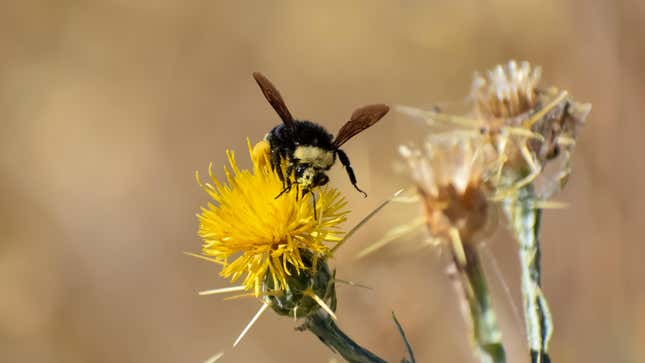
Some of California’s most crucial insects seem to have gone missing. A new study suggests that populations of once-abundant bumble bee species in California may have experienced serious decline, after researchers conducted the first statewide survey of bumble bee species in 40 years.
Unlike their popular cousins, bumble bees don’t create honey for human consumption. But also unlike honey bees, bumble bees are native to North America and are crucial pollinators for native plants and flowers.
California is a particularly important place for bumble bees. The state is home to 25 different species of bumble bees—about half the total number of species in the country. Bumble bees originally developed on the Tibetan plateau, meaning they thrive in mountainous regions like the Sierra Nevada, an area rich in bee species.
But California is also a hotspot for the big problems that plague bees across the country. Human settlement in bee habitats is pushing them out. Agriculture in the Central Valley has decimated the grasslands where bees once thrived and introduced pesticides that can kill bumble bees or reduce important activity like foraging, reproducing, and eating, as well as potentially limiting the production of queens. And climate change is hitting ecosystems in the state hard, threatening bee habitats, spreading diseases, and causing disruptions as some flowers bloom earlier.
In the early 1980s, a famed entomologist named Robbin Thorp conducted a wide survey of bees in California, documenting broad patterns of bee populations in multiple habitats. Woodard said that this new survey was inspired by his work.
“If you go to a place where Robbin Thorp would have visited in the 80s and you just skim, and you take minimal collections, can you take a snapshot of bees in one place at one time and do you see the patterns that he saw?” said Hollis Woodard, an entomologist at the University of California, Riverside and an author of the study. “The answer is no, mostly. [The study] strongly suggests that our state has undergone some massive changes when it comes to our bumble bee populations.”
To conduct the survey, Woodard and her labmates visited 17 sites throughout California, representing a wide variety of bee habitats and six different ecosystems. At each site, they attempted to collect 100 bee samples, taking the bees back to their lab for identification.
The study, published in a recent issue of Ecology and Evolution, was not meant to be comprehensive, Woodard said, but was meant to give the researchers an idea of what species were present and common in each area.
For some species of bees, the results were disheartening but not unexpected. Woodard said she didn’t expect to find some rarer species—like Bombus franklini, or Franklin’s bumblebee, which was last sighted in 2006—in the survey, thanks to known declines in their population.
“Some of [California’s bees] have always been rare, but now they’re so rare that no one has seen them in more than 20 years,” she said.
But some of the results were much more surprising—and worrying. Bombus vosnesenskii, or the yellow-faced bumblebee, was the most common species of bee found in the study. But Woodard said that the range and sampling of this bee was much more limited than what it was back when Thorp was surveying the bees.
“I went to places where I should have seen it, and I couldn’t find it,” she said. “Relative to other species, it looks like it’s doing amazingly, but if you compare it to itself, you’re not seeing it where you used to see it. It was pretty upsetting.”
In fact, the collection of bees species at four sites in Southern California were not included in the study, since researchers couldn’t find more than 10 bees per site during their visits.
“As I drove around California looking for these bees and talking to people, I heard all these stories of people saying we used to have bees and we just don’t have them any more,” Woodard said. “I think the more we look for these bees, we’re going to have more unfortunate surprises in store.”
Woodard emphasized that there are policy solutions in play that could help bee populations, including listing more species under both state and federal endangered species lists, as well as banning certain pesticides. And she says that citizen-led survey projects like California’s Bumble Bee Atlas project, which trains ordinary people to look for and identify bees, are able to generate a much broader set of data than what her survey provided—and could provide more clues about the whereabouts or status of some of the rarer bees.
“Bumble bees are little, they fly around really fast, their population size can change a lot over years,” Woodard said. “There’s all kinds of reasons why it’s hard to find a bumblebee, so let’s go out and look.”